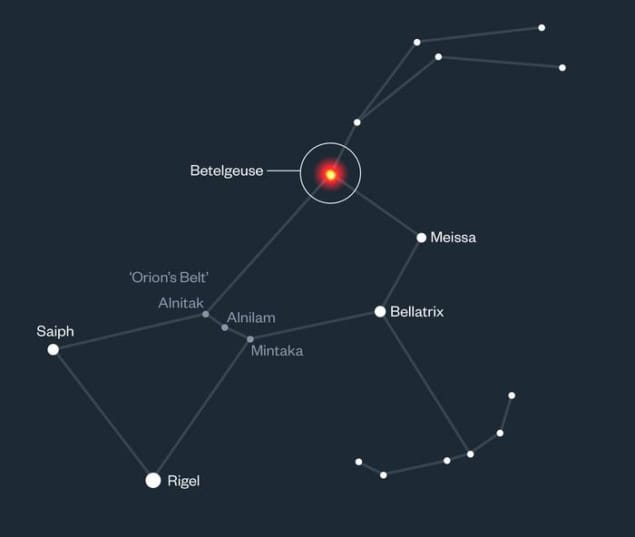
An unseen low-mass companion star may be responsible for the recently observed “Great Dimming” of the red supergiant star Betelgeuse. According to this hypothesis, which was put forward by researchers in the US and Hungary, the star’s apparent brightness varies when an orbiting companion – dubbed α Ori B or, less formally, “Betelbuddy” – displaces light-blocking dust, thereby changing how much of Betelgeuse’s light reaches the Earth.
Located about 548 light-years away, in the constellation Orion, Betelgeuse is the 10th brightest star in the night sky. Usually, its brightness varies over a period of 416 days, but in 2019–2020, its output dropped to the lowest level ever recorded.
At the time, some astrophysicists speculated that this “Great Dimming” might mean that the star was reaching the end of its life and would soon explode as a supernova. Over the next three years, however, Betelgeuse’s brightness recovered, and alternative hypotheses gained favour. One such suggestion is that a cooler spot formed on the star and began ejecting material and dust, causing its light to dim as seen from Earth.
Pulsation periods
The latest hypothesis was inspired, in part, by the fact that Betelgeuse experiences another cycle in addition to its fundamental 416-day pulsation period. This second cycle, known as the long secondary period (LSP), lasts 2170 days, and the Great Dimming occurred after its minimum brightness coincided with a minimum in the 416-day cycle.
While astrophysicists are not entirely sure what causes LSPs, one leading theory suggest that they stem from a companion star. As this companion orbits its parent star, it displaces the cosmic dust the star produces and expels, which in turn changes the amount of starlight that reaches us.
Lots of observational data
To understand whether this might be happening with Betelgeuse, a team led by Jared Goldberg at the Flatiron Institute’s Center for Computational Astrophysics; Meridith Joyce at the University of Wyoming; and László Molnár of the Konkoly Observatory, HUN-REN CSFK, Budapest; analysed a wealth of observational data from the American Association of Variable Star Observers. “This association has been collecting data from both professional and amateur astronomers, so we had access to decades worth of data,” explains Molnár. “We also looked at data from the space-based SMEI instrument and spectroscopic observations collected by the STELLA robotic telescope.”
The researchers combined these direct-observation data with advanced computer models that simulate Betelgeuse’s activity. When they studied how the star’s brightness and its velocity varied relative to each other, they realized that the brightest phase must correspond to a companion being in front of it. “This is the opposite of what others have proposed,” Molnár notes. “For example, one popular hypothesis postulates that companions are enveloped in dense dust clouds, obscuring the giant star when they pass in front of them. But in this case, the companion must remove dust from its vicinity.”
As for how the companion does this, Molnár says they are not sure whether it evaporates the dust away or shepherds it to the opposite side of Betelgeuse with its gravitational pull. Both are possible, and Goldberg adds that other processes may also contribute. “Our new hypothesis complements the previous one involving the formation of a cooler spot on the star that ejects material and dust,” he says. “The dust ejection could occur because the companion star was out of the way, behind Betelgeuse rather than along the line of sight.”
The least absurd of all hypotheses?
The prospect of a connection between an LSP and the activity of a companion star is a longstanding one, Goldberg tells Physics World. “We know the Betelgeuse has an LSP and if an LSP exists, that means a ‘buddy’ for Betelgeuse,” he says.
The researchers weren’t always so confident, though. Indeed, they initially thought the idea of a companion star for Betelgeuse was absurd, so the hardest part of their work was to prove to themselves that this was, in fact, the least absurd of all hypotheses for what was causing the LSP.

Weather satellite sheds light on ‘Great Dimming’ of Betelgeuse star
“We’ve been interested in Betelgeuse for a while now, and in a previous paper, led by Meridith, we already provided new size, distance and mass estimates for the star based on our models,” says Molnár. “Our new data started to point in one direction, but first we had to convince ourselves that we were right and that our claims are novel.”
The findings could have more far-reaching implications, he adds. While around one third of all red giants and supergiants have LSPs, the relationships between LSPs and brightness vary. “There are therefore a host of targets out there and potentially a need for more detailed models on how companions and dust clouds may interact,” Molnár says.
The researchers are now applying for observing time on space telescopes in hopes of finding direct evidence that the companion exists. One challenge they face is that because Betelgeuse is so bright – indeed, too bright for many sensitive instruments – a “Betelbuddy”, as Goldberg has nicknamed it, may be simpler to explain than it is to observe. “We’re throwing everything we can at it to actually find it,” Molnár says. “We have some ideas on how to detect its radiation in a way that can be separated from the absolute deluge of light Betelgeuse is producing, but we have to collect and analyse our data first.”
The study is published in The Astrophysical Journal.



